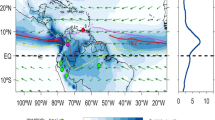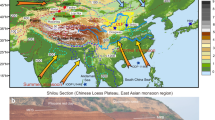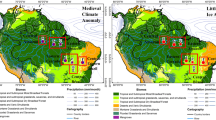Abstract
The strong present-day Asian monsoons are thought to have originated between 25 and 22 million years (Myr) ago, driven by Tibetan–Himalayan uplift. However, the existence of older Asian monsoons and their response to enhanced greenhouse conditions such as those in the Eocene period (55–34 Myr ago) are unknown because of the paucity of well-dated records. Here we show late Eocene climate records revealing marked monsoon-like patterns in rainfall and wind south and north of the Tibetan–Himalayan orogen. This is indicated by low oxygen isotope values with strong seasonality in gastropod shells and mammal teeth from Myanmar, and by aeolian dust deposition in northwest China. Our climate simulations support modern-like Eocene monsoonal rainfall and show that a reinforced hydrological cycle responding to enhanced greenhouse conditions counterbalanced the negative effect of lower Tibetan relief on precipitation. These strong monsoons later weakened with the global shift to icehouse conditions 34 Myr ago.
This is a preview of subscription content, access via your institution
Access options
Subscribe to this journal
Receive 51 print issues and online access
$199.00 per year
only $3.90 per issue
Buy this article
- Purchase on Springer Link
- Instant access to full article PDF
Prices may be subject to local taxes which are calculated during checkout





Similar content being viewed by others
References
Xu, M. et al. Steady decline of east Asian monsoon winds, 1969–2000: evidence from direct ground measurements of wind speed. J. Geophys. Res. 111, D24111 (2006)
Zhang, S. & Wang, B. Global summer monsoon rainy seasons. Int. J. Climatol. 28, 1563–1578 (2008)
Prell, W. & Kutzbach, J. Sensitivity of the Indian Monsoon to forcing parameters and implications for its evolution. Nature 360, 647–652 (1992)
Boos, W. & Kuang, Z. Dominant control of the South Asian monsoon by orographic insulation versus plateau heating. Nature 463, 218–222 (2010)
Clift, P. et al. Correlation of Himalayan exhumation rates and Asian monsoon intensity. Nature Geosci. 351, 875–881 (2008)
Rowley, D. & Currie, B. Paleo-altimetry of the late Eocene to Miocene Lunpola basin, central Tibet. Nature 439, 677–681 (2006)
Dupont-Nivet, G., Hoorn, C. & Konert, M. Tibetan uplift prior to the Eocene–Oligocene climate transition: evidence from pollen analysis of the Xining Basin. Geology 36, 987–990 (2008)
Molnar, P., Boos, W. & Battisti, D. Orographic controls on climate and paleoclimate of Asia: thermal and mechanical roles for the Tibetan Plateau. Annu. Rev. Earth Planet. Sci. 38, 77–102 (2010)
Guo, Z. et al. Onset of Asian desertification by 22 Myr ago inferred from loess deposits in China. Nature 416, 159–163 (2002)
Qiang, X. et al. New eolian red clay sequence on the western Chinese Loess Plateau linked to onset of Asian desertification about 25 Ma ago. Sci. China Earth Sci. 54, 136–144 (2011)
Sun, X. & Wang, P. How old is the Asian monsoon system? Paleobotanical records from China. Palaeogeogr. Palaeoclimatol. Palaeoecol. 222, 181–222 (2005)
Pagani, M., Zachos, J., Freeman, K., Tipple, B. & Bohaty, S. Marked decline in atmospheric carbon dioxide concentrations during the Paleogene. Science 309, 600–603 (2005)
Zachos, J., Pagani, M., Sloan, L., Thomas, E. & Billups, K. Trends, rhythms, and aberrations in global climate 65 Ma to present. Science 292, 686–693 (2001)
Ramstein, G., Fluteau, F., Besse, J. & Joussaume, S. Effect of orogeny, plate motion and land–sea distribution on Eurasian climate change over the past 30 million years. Nature 386, 788–795 (1997)
Fluteau, F., Ramstein, G. & Besse, J. Simulating the evolution of the Asian and African monsoons during the past 30 Myr using an atmospheric general circulation model. J. Geophys. Res. 104, 11995–12018 (1999)
Zhang, Z., Wang, H., Guo, Z. & Jiang, D. Impacts of tectonic changes on the reorganization of the Cenozoic paleoclimatic patterns in China. Earth Planet. Sci. Lett. 257, 622–634 (2007)
Zhang, Z. et al. Early Eocene Asian climate dominated by desert and steppe with limited monsoons. J. Asian Earth Sci. 44, 24–35 (2012)
Bosboom, R. et al. Late Eocene sea retreat from the Tarim Basin (west China), and concomitant Asian paleoenvironmental change. Palaeogeogr. Palaeoclimatol. Palaeoecol. 299, 385–398 (2011)
Huber, M. & Goldner, A. Eocene monsoons. J. Asian Earth Sci. 44, 3–23 (2012)
Quan, C., Liu, Y. & Utescher, T. Eocene monsoon prevalence over China: a paleobotanical perspective. Palaeogeogr. Palaeoclimatol. Palaeoecol. 365–366, 302–311 (2012)
Wang, D., Lu, S., Han, S., Sun, X. & Quan, C. Eocene prevalence of monsoon-like climate over eastern China reflected by hydrological dynamics. J. Asian Earth Sci. 62, 776–787 (2013)
Dettman, D. et al. Seasonal stable isotope evidence for a strong Asian monsoon throughout the past 10.7 m.y. Geology 29, 31–34 (2001)
Sharma, S. et al. Oxygen isotopes of bovid teeth as archives of paleoclimatic variations in archaeological deposits of the Ganga plain, India. Quat. Res. 62, 19–28 (2004)
Martin, C., Bentaleb, I. & Antoine, P. O. Pakistan mammal tooth stable isotopes show paleoclimatic and paleoenvironmental changes since the early Oligocene. Palaeogeogr. Palaeoclimatol. Palaeoecol. 311, 19–29 (2011)
Vuille, M., Werner, M., Bradley, R. S. & Keimig, F. Stable isotopes in precipitation in the Asian monsoon region. J. Geophys. Res. 110, D23108 (2005)
Breitenbach, S. et al. Strong influence of water vapor source dynamics on stable isotopes in precipitation observed in Southern Meghalaya, NE India. Earth Planet. Sci. Lett. 292, 212–220 (2010)
Araguas-Araguas, L., Froehlich, K. & Rozanski, K. Stable isotope composition of precipitation over southeast Asia. J. Geophys. Res. 742, 721–728 (1998)
Grossman, E. & Ku, T. Oxygen and carbon isotope fractionation in biogenic aragonite: temperature effects. Chem. Geol. 59, 59–74 (1986)
Gajurel, A., France-Lanord, C., Huyghe, P., Guilmette, C. & Gurung, D. C and O isotope compositions of modern fresh-water mollusc shells and river waters from the Himalaya and Ganga plain. Chem. Geol. 233, 156–183 (2006)
Kohn, M., Schoeninger, M. & Valley, J. Herbivor tooth oxygen isotope compositions: effects of diet and physiology. Geochim. Cosmochim. Acta 60, 3889–3896 (1996)
Licht, A. et al. A palaeo Tibet–Myanmar connection? Reconstructing the Late Eocene drainage system of central Myanmar using a multi-proxy approach. J. Geol. Soc. Lond. 170, 929–939 (2013)
Tindall, J. et al. Modelling the oxygen isotope distribution of ancient seawater using a coupled ocean–atmosphere GCM: implications for reconstructing early Eocene climate. Earth Planet. Sci. Lett. 292, 265–273 (2010)
Tafforeau, P., Bentaleb, I., Jaeger, J. & Martin, C. Nature of laminations and mineralization in rhinoceros enamel using histology and X-ray synchrotron microtomography: potential implications for palaeoenvironmental isotopic studies. Palaeogeogr. Palaeoclimatol. Palaeoecol. 246, 206–227 (2007)
Jaeger, J. J. et al. Systematics and paleobiology of the anthropoid primate Pondaungia from the late Middle Eocene of Myanmar. C. R. Palevol 3, 243–255 (2004)
Licht, A. et al. Influence of permeability barriers in alluvial hydromorphic palaeosols: the Eocene Pondaung Formation, Myanmar. Sedimentology 61, 362–382 (2014)
Licht, A. et al. Fossil woods from the Late Middle Eocene Pondaung Formation, Myanmar. Rev. Palaeobot. Palynol. 202, 29–46 (2014)
Dupont-Nivet, G. et al. Tibetan plateau aridification linked to global cooling at the Eocene–Oligocene transition. Nature 445, 635–638 (2007)
Abels, H. A., Dupont-Nivet, G., Xiao, G., Bosboom, R. & Krijgsman, W. Step-wise change of Asian interior climate preceding the Eocene–Oligocene transition (EOT). Palaeogeogr. Palaeoclimatol. Palaeoecol. 299, 399–412 (2011)
Krinsley, D. & Doornkamp, J. Atlas of Quartz Sand Surface Textures (Cambridge Univ. Press, 1973)
Vandenberghe, J. Grain size of fine-grained windblown sediment: a powerful proxy for process identification. Earth Sci. Rev. 121, 18–30 (2013)
Lu, H., Vandenberghe, J. & An, Z. Aeolian origin and palaeoclimatic implications of the ‘Red Clay’ (north China) as evidenced by grain-size distribution. J. Quat. Sci. 16, 89–97 (2001)
Sun, D., Su, R., Bloemendal, J. & Lu, H. Grain-size and accumulation rate records from Late Cenozoic aeolian sequences in northern China: implications for variations in the East Asian winter monsoon and westerly atmospheric circulation. Palaeogeogr. Palaeoclimatol. Palaeoecol. 264, 39–53 (2008)
Alonso-Zarza, A. et al. Mudflat/distal fan and shallow lake sedimentation (upper Vallesian–Turolian) in the Tianshui Basin, Central China: evidence against the late Miocene eolian loess. Sedim. Geol. 222, 42–51 (2009)
Hourdin, F. et al. The LMDZ4 general circulation model: climate performance and sensitivity to parametrized physics with emphasis on tropical convection. Clim. Dyn. 27, 787–813 (2006)
Seton, M. et al. Global continental and ocean basin reconstructions since 200 Ma. Earth-Sci. Rev. 113, 212–270 (2012)
Hall, R. Late Jurassic–Cenozoic reconstructions of the Indonesian region and the Indian Ocean. Tectonophysics 570–571, 1–41 (2012)
Wilson, D. et al. Antarctic topography at the Eocene–Oligocene boundary. Palaeogeogr. Palaeoclimatol. Palaeoecol. 335–336, 24–34 (2012)
DeConto, R., Pollard, D. & Harwood, D. Sea ice feedback and Cenozoic evolution of Antarctic climate and ice sheets. Paleoceanography 22, PA3214 (2007)
Lefebvre, V., Donnadieu, Y., Sepulchre, P., Swingedouw, D. & Zhang, Z. Deciphering the role of southern gateways and carbon dioxide on the onset of the Antarctic Circumpolar Current. Paleoceanography 27, PA4201 (2012)
Laskar, J. et al. A long-term numerical solution for the insolation quantities of the Earth. Astron. Astrophys. 428, 261–285 (2004)
Acknowledgements
We thank the Commissariat a l'Energie Atomique/Centre de Calcul Recherche et Technologie for access to computing facilities; V. Barbin for cathodoluminescence microscopy; C. Fontaine for X-ray diffraction; R. Amiot, T. Bouten, M. Konert, M. Lebbink and T. Zalm for laboratory assistance; the many colleagues of the Franco-Burmese palaeontological team for field assistance; and D. Dettman and F. Fluteau for discussions. This work was supported by the ANR-09-BLAN-0238-02 Program, the University of Poitiers, the Netherlands Organisation for Scientific Research (NWO-ALW) with funding to H.A. and G.D.-N., the Marie Curie CIG 294282, the Ministry of Culture of the Republic of the Union of Myanmar, the French ministries of Foreign Affairs and of Higher Education and Research, the Alexander von Humboldt Foundation, the Chinese Ministry of Education and the National Natural Science Foundation of China (NSFC). A.L. was also funded by a Fyssen Foundation study grant.
Author information
Authors and Affiliations
Contributions
A.L., J.-J.J., H.A. and G.D.-N. conceived the project. A.L., A.N.S. and J.-J.J. collected Burmese samples. A.L., T.R., C.F.-L. and C.L. performed isotopic analyses. H.A., G.D.-N., M.v.C., D.T. and Z.G. collected Chinese samples. M.v.C., H.A., J.T.A., D.T., J.V. and R.A. performed petrographic and grain-size analyses of the Xining sediment. J.-B.L. and Y.D. conducted numerical climate modelling. A.L., H.A., M.v.C. and G.D.-N. wrote the manuscript with contributions from all authors.
Corresponding author
Ethics declarations
Competing interests
The authors declare no competing financial interests.
Extended data figures and tables
Extended Data Figure 1 Palaeogeographic world maps of climatic simulations.
a, Palaeogeography at 40 Myr ago, built from the compilation of recently published reconstructions6,45,46,47. b, Palaeogeography at 34 Myr ago, extracted from another study49, showing a slightly lower resolution. The main differences in the map for 34 Myr ago are the retreat of the Tarim Sea, the northward motion of India and the eastward extrusion of Indochina. Note also that the reconstruction for 34 Myr ago shows higher altitudes in northern China and shallower marine depths in the Arctic Ocean and in the equatorial seas north to Australia as a result of the lower resolution.
Extended Data Figure 3 Quartz grain surface textures from red mudstone samples of the Shuiwan section.
a–f, SEM pictures displaying smooth precipitation surfaces (SMS; a, d), adhering clay particles (ACP; b, e, f), upturned plates (UP; b, f), and dish-shaped depression (DSD; c, d).
Extended Data Figure 4 Summer insolation during the Middle–late Eocene.
Data are averaged over Asia (0–45°N, 45–120°E), calculated from Earth’s orbital parameters of the 45–34 Myr period50, compared with the summer insolation of the warm austral and warm boreal scenarios.
Extended Data Figure 5 Diagenetic screening of Burmese fossil material.
a, Cathodoluminescence image of a shell fragment from the Eocene Pondaung Formation. Blue colour indicates a predominance of pure aragonite in the shell material; note the absence of red spots that are typical of calcite. Growth lines are well defined in the outer and inner layers of the shell. b, c, SEM pictures of a Pondaung shell fragment at low (b) and high (c) magnification. The excellent preservation of the aragonitic crossed laminar structure within the central layer of the shell indicates the absence of recrystallization. d, Comparison of the oxygen isotopic composition of the phosphate (δ18Op) and carbonate (δ18Oc) phases of single samples from the ten fossil individuals from the Pondaung Formation. Results fall in the range of the modern mammals, which is consistent with an absence of diagenetic impact on the isotopic composition of the fossil enamel24.
Supplementary information
Supplementary Data
This file contains Supplementary Tables 1-3. (XLS 54 kb)
Supplementary Data
This file contains Supplementary Tables 4-5. (XLS 82 kb)
Rights and permissions
About this article
Cite this article
Licht, A., van Cappelle, M., Abels, H. et al. Asian monsoons in a late Eocene greenhouse world. Nature 513, 501–506 (2014). https://doi.org/10.1038/nature13704
Received:
Accepted:
Published:
Issue Date:
DOI: https://doi.org/10.1038/nature13704
This article is cited by
-
Proto-monsoon rainfall and greening in Central Asia due to extreme early Eocene warmth
Nature Geoscience (2024)
-
Unraveling weak and short South Asian wet season in the Early Eocene warmth
Communications Earth & Environment (2024)
-
Early Paleogene precipitation patterns over East Asia: Was there a monsoon after all?
Palaeobiodiversity and Palaeoenvironments (2024)
-
Emergence of the modern global monsoon from the Pangaea megamonsoon set by palaeogeography
Nature Geoscience (2023)
-
Weakening of the South Asian summer monsoon linked to interhemispheric ice-sheet growth since 12 Ma
Nature Communications (2023)
Comments
By submitting a comment you agree to abide by our Terms and Community Guidelines. If you find something abusive or that does not comply with our terms or guidelines please flag it as inappropriate.



